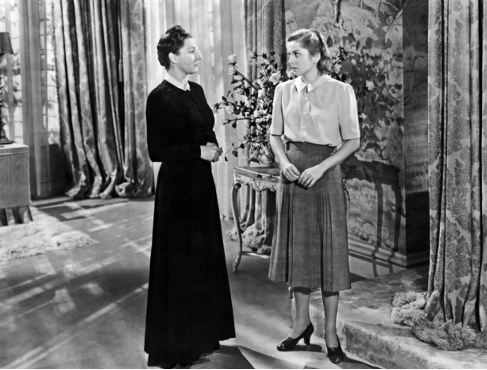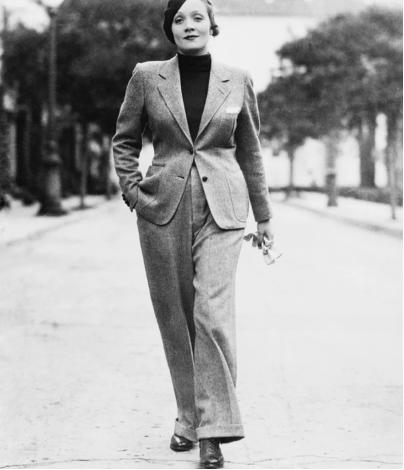History & Fiction Series: Rebecca and 1930s Fashion
- tizanenr
- Apr 30, 2022
- 6 min read
Updated: Jun 3, 2022
“Last night I dreamt I went to Manderley again.”
So goes the iconic opening line of the 1938 novel Rebecca by Daphne du Maurier. I raced through the book a few weeks ago and fell in love with it. While the novel exudes a gothic, haunting atmosphere, it is also dripping with Thirties style and glamour. In fact, the 1940 Alfred Hitchcock adaptation was marketed as just that: “The Most Glamourous Motion Picture Ever Made”.
Rebecca follows the story of an unnamed young woman working as a ladies’ companion in Monte Carlo. After a whirlwind romance, our protagonist marries the handsome and wealthy widower, Maxim de Winter. However, when the newly wedded couple return to Maxim’s resplendent Cornwall estate, they struggle to achieve marital bliss as they are haunted by the memory of the late Mrs de Winter (the titular Rebecca) who died the previous year in mysterious circumstances.
In the novel and its adaptations, clothing is imbued with symbolic value. Threading throughout, the character's clothes are often used to embody status, personality and taste. So, let’s put the book into some context and dive into a little 1930s fashion history!
Clothing during the Roaring Twenties was exuberant and modern, with shorter dresses and the use of synthetic fabrics. However, in the 1930s, fashion saw a return to conservatism, evolving from boyish cuts to more feminine silhouettes. On the whole, Thirties clothing was modest and form-fitting, accentuating a natural ‘high’ waist. Cuts were fitted around the hips and hemlines sunk back down the leg. Necklines were high and shoulders were structured and wide.
In short, Thirties fashion was trim, tailored, modest and feminine.
But the Thirties was also an era of contrasts. While we see the rise of mass-produced garments made from cheaper, synthetic fabrics and a flourishing catalogue market (e.g. Littlewoods), the decade also saw the ascendancy of Old Hollywood glamour. Actresses such as Bette Davis, Marlene Dietrich and Vivienne Leigh fashioning themselves into style icons.
Yet, in Rebecca, our unnamed heroine is unable to exude a sense of sartorial glamour. Indeed, this becomes a source of anxiety for the character, as she begins to view herself as second-rate to the “exquisitely turned out” and fashionably minded Rebecca. She is simply not ready for the performance she is expected to play in her new life as Mrs de Winter. Rather, coming from a humble background, Mrs de Winter’s closet is a modest one with dowdy hand-me-down suits and home-made garments:
I can see myself now, memory spanning the years like a bridge, with straight, bobbed hair and youthful powdered face, dressed in an ill-fitting coat and skirt and a jumper of my own creation.
Rather, in the naivety of her youth, she so desperately wishes she “was a woman of about thirty-six dressed in black satin with a string of pearls."
Mrs de Winter’s simple clothing. Stills from Rebecca (Dir. Alfred Hitchcock, 1940).
Day Wear
Rebecca is littered with passages that illustrate Mrs de Winter’s functional and unvaried wardrobe. In one passage, she recounts her typical day wear in detail:
I can remember as though I wore it still my comfortable, ill-fitting flannel suit, and how the skirt was lighter than the coat through harder wear. My shabby hat, too broad about the brim, and low-heeled shoes, fastened with a single strap. A pair of gauntlet gloves clutched in a grubby hand.
Smart day-suits were indeed very popular during the Thirties, which favoured clean silhouettes and sculptured, defined shoulders. Just like Mrs de Winter’s “flannel” and “woolly” suits, less expensive fabrics grew in popularity throughout the decade. So-called “rough” or “peasant” fabrics, as well as cotton, became the trend.

Above: 1935 Tweed Suit (left), 1938 Anne-Shirley in a woollen day-suit with a large brimmed hat (right). Perhaps a tad nicer than what Mrs de Winter would have worn!
In a typical day ensemble, you might pair your smart jacket with a blouse or top and a mid-length skirt (as pictured above). Maybe you’ve purchased a blouse and skirt set, designed to match. Among other options, you might’ve worn day or afternoon dresses, dresses with matching bolero (a cropped jacket) or cape. These ensembles would likely have been topped with a fur or wool coat in colder seasons. And since this is the 1930s, a myriad of accessories were the trend: hat, gauntlet gloves, scarf, handbag and low-heeled, sturdy courts.
Dress and knitting patterns were also in high demand during this period, as women continued to opt for home sewing in their droves, just like our Mrs de Winter who wore a jumper of her “own creation”. In the 1930s, the vast majority of women in England sewed and knitted their own garments, such as vests, jumpers, scarves and even sometimes their own girdles! But knitting also became a popular pastime among the ‘young’ and ‘trendy’ who favoured brightly coloured yarn and intricate stitches. Such garments feature in Mrs de Winter’s own closet with references to a stockinette day-dress “with bare shoulders”. Indeed, knits were a staple of 1930s day wear. Simple, comfortable and, to some, highly fashionable.
The Evening Dress
There is a scene in Rebecca where our protagonist ventures into the dust-sheeted old rooms in the west wing of the house. These rooms had once been occupied by the late Mrs de Winter when she was alive. Our heroine, driven by an aching curiosity, explores the rooms, including Rebecca’s closet filled to the brim with luxurious dresses and furs. Here, she describes the elegant gowns:
I caught the shimmer of silver over the top of the white bags that enfolded them. There was a piece of gold brocade. There, next to it, was velvet, wine-colored and soft. There was a train of white satin, dripping on the floor of the wardrobe. Peeping out from a piece of tissue paper on a shelf above was an ostrich feather fan.
Shortly after, in a bout of possessive devotion to the titular Rebecca, Mrs Danvers proceeds to taunt Mrs de Winter with these garments, cooing “Mr. de Winter liked [Rebecca] to wear silver mostly […] She looked beautiful in velvet”. Mrs Danvers then caresses Rebecca’s furs, the sable and chinchilla wraps that Rebecca would have slung around her shoulders on cold nights.
The colours and sumptuous materials come to life on the page, epitomising the shimmering simplicity of 1930s evening gowns. Silky, “dripping” fabrics were most popular during this period, such as chiffon, silk, crepe-de-chines and satin. Metallic lame also came into fashion during this time. Material was typically cut on the bias to create elegant, flowing lines that draped along the figure. Here, designers were inspired by the images of Greek goddesses. The dresses were long line, with floor length hems and often small trains in the back. The effect was subtle, softly accentuating the waist. They certainly posed in stark contrast to the body sculpting corsetry, hoops and pads of previous decades.
Left: Silver evening dress like Rebecca would have worn, 1932. Designed by Madeleine Vionnet (1876-1975
Right: Illustrations of 1930s Evening Gowns
Looking at the above images, you can see how evening gowns of the Thirties were all about luxurious minimalism. The focus was on the cut of the dress, the fall of the trail and the garment’s movement. Dresses were designed to be effortlessly simple, where one could glide languidly in a manner of controlled, sophisticated carelessness.
Trousers?
Yes, women wore trousers! Or ‘slacks’ as they were typically known in the 1930s. In the novel, Mrs Danvers supposes that Rebecca was wearing “slacks and a shirt” at the time of her death, as she was an active woman who enjoyed sailing. Trousers were simply the more practical choice! Indeed, during the Thirties, slacks were worn exactly for these functional purposes. Sportswear such as overalls, trousers or shorts were worn for the beach, playing sports or even just watching sports.
Slacks were typically wide legged, with a front crease (or very wide, flowing culottes) and a high fitted waist. Beyond days at the beach or playing sports, women didn’t typically wear pants during this era. However, Hollywood actresses were instrumental in putting trousers on the map! The likes of Marlene Dietrich and Katherine Hepburn were pictured donning slacks, challenging the gender norms of their day. At the time, wearing pantsuits so openly was not without controversy but these iconic stars paved the way for the gradual popularisation of trousers and the chic pant suits we see on the red carpet today.
Left: Marlene Dietrich wearing a suit in 1933
Right: Katherine Hepburn wearing trousers at an ice rink in 1936
And so, intrepid time-traveller...
Here, we reach the end of our whistle-stop tour of 1930s fashion. Whether it be grubby day suits, elegant evening gowns or trend-setting 'slacks', these garments thread throughout Rebecca and are shown in delicious detail on screen. They form part of the story's background tapestry, and in the case of Rebecca herself, adds to her tantalising mystery. We never actually meet Rebecca, we only experience her through the possessions she leaves behind. And it is her clothes that stoke the torment and insatiable curiosity of our naive, grubbily-dressed protagonist.
























Comments